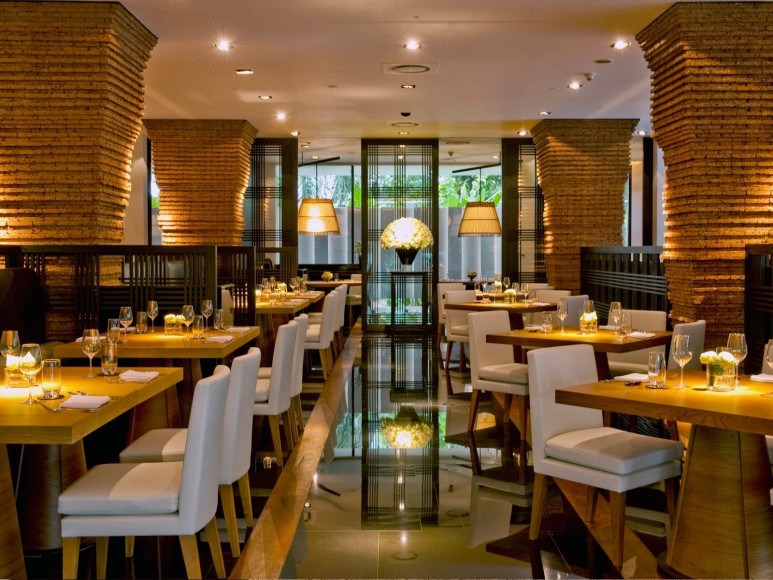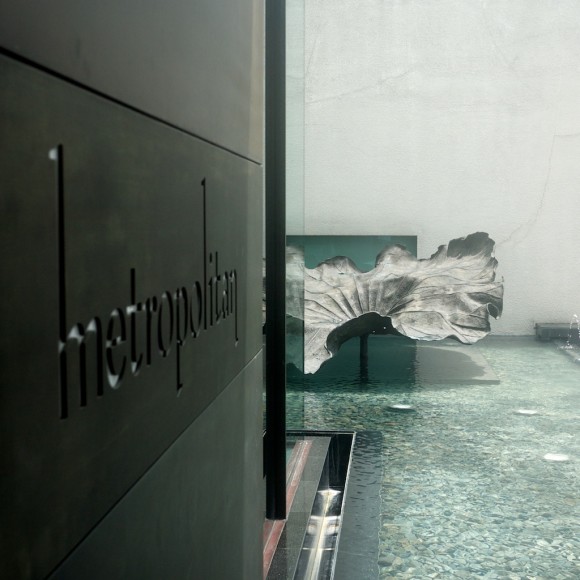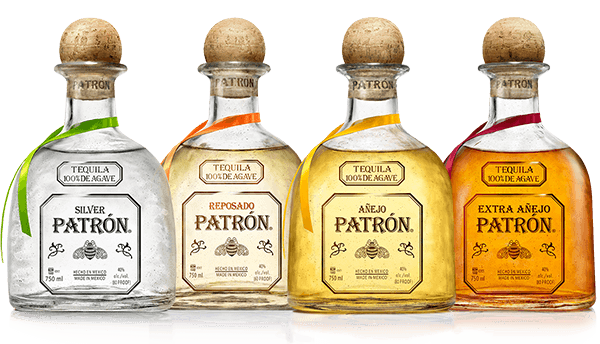From street stalls to hipster bars, from single plate meals to exquisite sharing menus, Bangkok will thrill your palate. Former Bangkok dweller Amy McNichol finds out where to dine.
Mmm, Thai food! Delicious, right? What could be better than dunking a fistful full of prawn crackers into a polystyrene tub of acidic orange gloop and shovelling them into your trap while they fizz? For mains, it’s a vat of watery, green curry and a brick of tooth-decayingly sweet coconut rice that has been packed in to, and moulded by, its plastic takeaway box. As it flops out onto the plate and smashes like a poorly made sand castle, remember, Thai food was not intended to be like this!
Whether you’re calling up the local takeaway, or you’re actually there, on holiday in Thailand, sticking to what you know is a crying shame – especially if it’s a dumbed down version for ferrangs (Westerners). Taste buds are there to be titillated, right? And Thailand can do that to every last one of ‘em.
Thai cuisine is vivacious and varies widely between provinces. Despite being the poorest area, the rural, north east of the country is famed for its robust flavours in its salads. The south has more wet dishes such as head-spinningly hot, coconut based curries while northern curries are often peanut-based. Few folk visit Thailand without flying through and spending a couple of days in the enchanting and seductive clutches of Bangkok. Luckily for foodie tourists, Bangkok and the central planes are an exhilarating territory as they are the wealthiest and have easy access to a huge array of ingredients. With this in mind, there really is no excuse for being ‘safe’ or boring.
Chef David Thompson, whose London restaurant nahm was the first Thai restaurant to be awarded a Michelin Star, first moved to Thailand, from Sydney, in the eighties. He has used Bangkok as a base ever since. He reckons it’s not difficult for locals or tourists to be experimental. As well as food playing a huge role in the family home, somewhere that is out of bounds for most tourists, high quality meals are available to most, including visitors, in the street.
“Wherever there is a lot of trade and wherever there are people passing by, there will be food stalls,” Thompson says. Seek out clusters of carts manned by a gaggle of locals. For example, a lady might be a som tam (spicy salad) specialist, pounding garlic, chillies, fish sauce, lime and green papaya in her pestle and mortar while the chap next to her might be a chicken noodle soup aficionado, dishing up broth from a steaming pot. Many of these stalls have no seating so the goods really are to be eaten on the hop but often, there are a couple of fold up tables set out under canopies. Diners perch on rickety plastic stools with a bottle of Singha while their feast is prepared in the open air.
“Street food shouldn’t be dismissed. There are some great cooks on the streets,” advises Thompson, who wrote culinary bible Thai Street Food (£25 by Conron Octopus) featuring recipes for his favourite street food dishes. He urges visitors to throw themselves off the well munched tourist path and experience the true flavours of Thailand. And how should we do this? For starters, we need to let go of our anxiety about street stalls being dirty. “Most street stall owners go to the market in the morning, make their dishes and sell them on the same day so everything is fresh,” says Thompson. “Thais are scrupulously clean. A street stall might look a little unprepossessing but often it’s those places that have the best food. If you’re squeamish or pernickety about places, you might miss out on a hell of lot of good eating!” he adds.
Nikki Sethasarn, The W Hotel ‘Insider’ agrees. “Visitors to W Bangkok (www.whotelbangkok.com) always ask me ‘where can I get the best pad Thai?’ But if they won’t go to a street food stall then they simply won’t get the best,” she laughs.
The origin of street food mostly lies in the Chinese community. Up until the 1920s, before the influx of Chinese immigrants, there wasn’t a great deal of it. Most Thais were farmers at this point and going out to eat wasn’t the done thing. However, when the Chinese started heading over to Thailand, many made themselves an honest living selling their dishes. They also brought with them noodles, yellow beans, pork and duck, all of which are now feature regularly in modern Thai cuisine.
Of course, the further away from the English-speaking tourist traps you wander, the harder it is to get what you want if you have something particular in mind. But what’s the worst that could happen? You’re served something you didn’t ask for, you try it, you don’t like it, you’ve spent less than a quid. What’s the best that can happen? Someone lovingly prepares you a dish, they present it to you with the pride that Thais are renowned for when it comes to their cuisine and you discover something freaking awesome that excites your mouth like nothing you’ve ever tasted before. Taking a punt can often turn out great.
“The way to find a good stall is to find one that is busy,” says Thompson, before assuring us, “it is busy for a reason.” Working on this advice, all foodie adventurers need to explore the area around Thong Lor BTS (sky train station) and Im Chan, the café that straddles both sides of a little road near Prom Pong BTS. The latter has a diverse menu in both English and Thai and both are bustling with the hungry bellies of young Thai professionals.
Originally, street food was single plate dishes (aharn jarn dtiaw) such as stir fries, plates of noodles or bowls of soup. It was things that were often eaten alone and or relatively quickly. Sometimes, this is still the case. Traditional Thai cuisine, in contrast, is food that is shared in the family home and usually eaten with rice. Nowadays however, the latter genre of food is common on the streets and in restaurants too. But no matter what, a Thai meal is always an exercise in balance.
An adept Thai chef will always strive for a harmony between their sweet and salty, hot and sour flavours. In fact, their condiment box reflects this as they contain sugar, fish sauce, chilli flakes and vinegar. These are usually used to pimp up a noodle dish.
When a meal consists of a banquet of dishes, balance is still very much the aim of the game. “You have things of varying techniques so you have a curry, a stir fry, a salad, a soup. They should also have diverse tastes so you might have one dish that’s hot, one dish that’s a bit sour, one that’s based on stock, a salad that’s salty and sharp and something that’s creamy and coconutty,” reveals Thompson. Indeed this is what he has accomplished with his sharing menu at nahm (www.comohotels.com/metropolitanbangkok/dining/nahm), Thompson’s restaurant in the blissful The Metropolitan hotel in Bangkok (www.comohotels.com/metropolitanbangkok). nahm has a string of accolades to its name, including being voted the best restaurant in Asia and thirty-second in the world. (And deservedly so, as it turns out).
“The tasting menu at nahm allows choice where a set menu doesn’t. That said, whatever you choose, you’ll get the balance that is so important,” smiles Thompson. And at around £40 per head, what superb value this menu is too. Everything from the amuse bouche (sticky minced pork bundled onto sweet pineapple) right through to the petit fours which included a thick white slug of melt in the mouth coconut cream, nahm is special.
The ambience is bob on too. The lighting is right, the level of music works to sooth and excite and when I head back to interview Mr Thompson, I am distracted by what’s going on behind him. There are four people standing with a measuring tape, ensuring the tables are spaced out, just so. Thompson has struck gold with his balance of style and substance. The Metropolitan hotel is big on relaxation and wellbeing and guests enjoy complimentary daily yoga and tai chi sessions. (Prices from £90 per night). It seems fitting then that many of nahm’s tables look over the peaceful, fairy lit pool.
Diners are presented with four canapés to start including one of salted threadfin perch with ginger, chilli and green mango on a betel leaf. My gosh, for such a small bite, this is one helluva flavour hit. It’s a decent warm up for the almighty banquet that’s about to be laid on too. Guests choose one dish from each section of the menu (sections include salads, soups, dipping dishes, curries and grilled meats) before they reach the sweet finale of dessert.
Highlights include an aromatic curry of Chiang Mai chicken with sweet potatoes and shallots and a clear soup of roast duck with Thai basil and young coconut which Thompson refers to as a “very suave soup” inspired by an old lady who was one of the first, Thai cook book writers.
As a westerner in Bangkok, it’s important to forget your prejudices regarding wines you’d deem suitable to accompany a meal. Where we would perhaps plump for a dry white with light, spicy food, Thais recommend medium as the sweetness compliments the salty element in the meal. nahm serves a range of Thai wines made from grapes grown in Khao Yai, or ‘grand mountain’, and why not? Just go with it.
Around the corner from (and 52 stories higher than) the understated luxury at The Metropolitan hotel and nahm, sits Breeze restaurant at Lebua (www.lebua.com/breeze). The hotel has made waves recently due to scenes in The Hangover Part II being filmed at the Tower Club’s open air Sirocco Sky Bar and super plush Dome restaurant on the sixty third floor. Although a teeny bit dated décor-wise, the vast suites are the height of luxury (pun-intended). Two bedroom suites cost around £250 per night and are super spacious. Sure, this might sound steep for south east Asia but you really do get a lot of bang for your buck here. Aside from impressive chandeliers and thick, fluffy carpets, guests staying in the suites have multiple balconies. Lebua’s views over the city are unrivalled and it’s possible to trace the Chao Phraya river winding itself between the capital’s contradictory markings of decadent skyscrapers and humble tin shack dwellings.
Guests at any of the restaurants at Lebua know when their bellies flip and their ears pop as they hurtle towards the summit, that they are in for something special. The lift pings open at floor 52. Diners are led through the dimly lit Tower Club lounge to a 25 metre neon-lit sky bridge down the centre of Breeze restaurant. For even the most well seasoned traveller, the view from here will not fail to wow. Shuffle your way right to the edge as this view is unbeatable. And it is all yours for the evening while you dine so pull up your chair and drink it in.
Quite in keeping then with the five-star establishment, the presentation at Breeze is also impressive. Although it is a pan Asian restaurant with a Chinese leaning, Malay executive chef Sam Pang, is happy to, and adept at, tailoring the set menu to dishes with a Thai influence if requested.
We kick off with a bite sized trio of silver fish on a spicy carrot salad, a small but mighty wasabi king prawn and a piece of chicken sushi. The tom yum seabass is a superb twist on the Thai staple tom yum which is traditionally served with prawn (goong). The chef splashes in a little condensed milk for richness and the balance of hot and creamy is a sublime combination. This precedes a super tasty peanut based pork curry served with crispy rice. Dessert is a delicate slither of light and refreshing green tea and dark chocolate gateaux.
The set menu at Breeze includes a trio of bite-sized starters, a soup, a third, a main and a dessert is not a cheap dinner at around £90 per person. And that’s before you get started on the magnificent ‘Hangovertini’ cocktails! For those who have spent up on bucket cocktails and ladyboy shows, as long as you have some smart casual threads with you, the open air Sky bar on floor 63 means you can soak up the views while spending a little less.
But rest assured whatever your budget, you can dine like royalty in Thailand. Be experimental, be ballsy and set out to challenge your taste buds whether it be 52 floors up wearing your gladrags, or down at a night market, with a damp brow and sweaty pits.
Whatever your budget, food is intrinsic to Thai culture and something the natives are eager to share with ferrangs. David Thompson is under no illusion about the importance of sustenance to the natives. “The Thais have two main parts to their society: their stomach and their soul and they look after both rather well,” he observes. During your next trip to the Land of Smiles, let them look after yours too.




